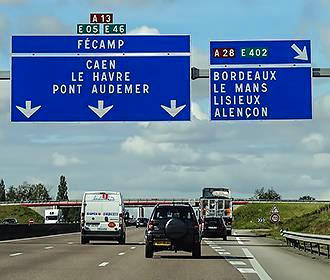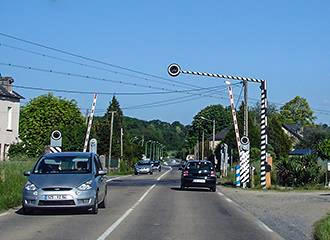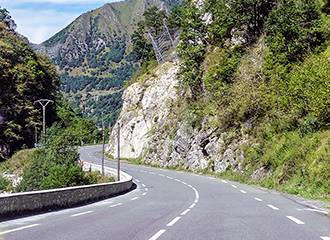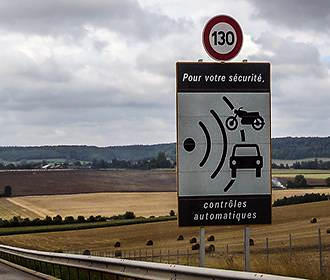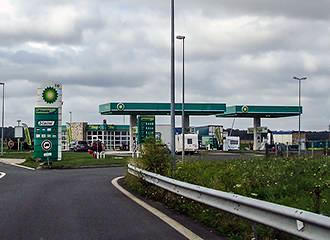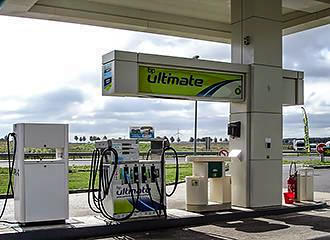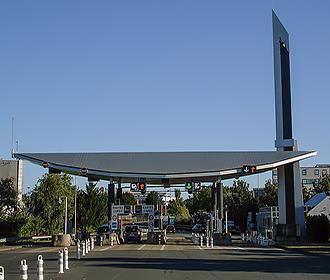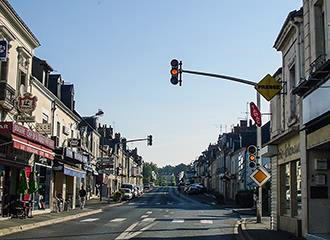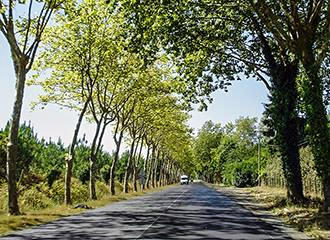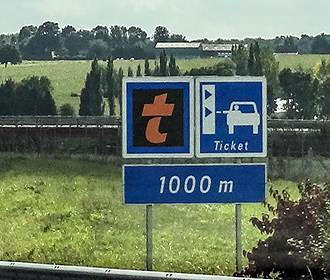The French roads and driving in France
Some helpful driving tips and guidelines for the French roads and driving in France to hopefully keep you out of trouble when touring, and make your holiday in France that bit more enjoyable.
Also see the new French Driving Regulations for UK Residents Post Brexit
Driving in France and French roads speed limits km/h
Now when your are driving in France on the many different French roads, the speed limits are different from the UK and are actually slightly faster on some French roads, but these are also always shown in kilometres (KM) rather than miles per hour (MPH).
The French roads speed limits on motorways are 130km per hour (km/h), but this is reduced in bad weather down to 110km per hour.
A French road duel carriageway is 110km per hour and main roads were 90km per hour, although as of July 2018 in an attempt to reduce accidents, this has been reduced to 80km per hour for roads that do not have a central reservation such as a barrier, with the periphery around Paris also being 80km per hour. But in bad weather the same rule as a motorway applies, where the speed limit is reduced.
French roads within towns and on minor roads there is a maximum of 50km per hour, although you will find that some roads are posted at even lower speeds.
The above speed limits are for private cars even if towing a caravan providing that the stated total gross weight of the whole outfit (example car and caravan combined weight) is less than 3,500kg. If you are above that weight, then the driving speed limit is reduced as you are classed as a heavy goods vehicle. For example, the maximum speed on a motorway is 90km per hour and again this is reduced down in bad weather conditions. Additionally, a newly qualified driver has to abide by the reduced speed limits at all times.
Do make sure you watch your speed when driving in France on the French roads! If you are stopped for speeding you can be fined on the spot and the fines have to be paid in cash there and then, which can be quite expensive. If you cannot pay or you are travelling more than 25km/h above the speed limit, then your car can be impounded and you could end up with a very hefty fine or even lose your licence.
Be very careful, especially when on the French toll roads as the time from entering and leaving is calculated as you go to pay and you do not want your camping holiday in France to come to an abrupt end!
The French Government do publish information on exactly where speed traps are located and this is one of the reasons why it is illegal to have a radar detector fitted to your vehicle and even if you have a Sat Nav system with this capability you must not have it turned on. You could end up with yet another hefty fine.
It is also illegal to wear headphones or earphones while driving in France, which came into effect in 2017 and you can receive an on the spot fine if you are caught out, which incudes those using motorcycycles.
French Roads Zebra crossings
Yes you will see lots of zebra crossings, especially in towns!
You must always stop at a zebra crossing when someone wishes to cross, which is enforced by law and in fact many people just step out expecting you to stop. However, as a pedestrian you should always be very careful, as the French do not seem to obey this rule as much as they should!
Driving in France and La priorite a droite
You will no doubt come across the term La Priorit a Droite at some point on your travels, which basically means that the vehicle coming onto a road has priority from the right. This is even the case when a minor French roads are entering a main road, so do be careful, especially when in the towns and villages as you would need to give way, even if it is you on the main road.
Officially this rule no longer applies unless clearly sign posted yet it still causes confusion and in Paris it is still widely practised. So you could end up feeling like you are being cut up, even though this may have been how the French were taught to drive when the Priorite a Droite rule was still widely used!
French roads and overtaking or passing on narrow roads
If you see a solid single line or a double solid line on any French roads, then you are not allowed to overtake, but if you do and you are caught out, then the penalties are severe!
When you are on a narrow road or going down a steep gradient then there are regulations you would have to abide by. For obvious reasons, if you are towing, then the other person that is not would have to reverse. However, if you are not towing, then it is the smaller or lower weight vehicle that has to reverse.
Flashing your lights are a way of saying I have the right of way or looking to pass another vehicle, which is something you will notice quite frequently when driving in France on the French roads and motorways as mentioned above.
If you are towing and on French roads that has three lanes or more, then you can only use the two right hand lanes, similar to the rules within the uk and therefore you cannot use the third lane to overtake.
French roads and parking
It is illegal to spend a night on the roadside with your caravan.
When it comes to parking, obviously every area is different, but as a general rule, parking on a street is limited to two hours. Many places are pay and display, although in Paris you do need to have a credit or prepaid card to park, rather than putting cash into a meter.
Stopping on the left hand side of the French roads is prohibited unless it is a one way street and normally if you see a yellow line (s) on the road side (just like in the UK) then you are not allowed to park.
Now when it comes to disabled parking this is very different from the UK. You still cannot park on yellow lines, no waiting zones, etc and even if in a designated disabled area within a car park, you will find that you still have to pay the same fee as everyone else.
Driving in France and Crit'Air vignette
Designed to help control air pollution, the French Government has put in place a scheme to help control the air purity in many of the major cities such as Paris, Marseille, Lyon, Grenoble, Strasbourg, etc.
The idea is that you have to display a sticker on your windscreen, which has become a legal requirement for all French drivers, but this is now a legal requirement for any person driving in France to have this clean air sticker when venturing into certain cities or zones, although it is not a legal requirement throughout the entire country as yet.
You will find that there are 6 colour coded stickers that define the category of your vehicle and its emissions, which range from the colour green to show these are the greenest of vehicles such as electric cars, through to a darkish grey colour for the most polluting vehicles, and in certain areas or certain days, etc, the most polluting of vehicles will not be allowed access to specific areas.
When you are entering a clean air zone you will see a sign with a red circle that states Circulation Restreinte below, and when the zone finishes, Fin de Zone in French, this will be a grey circle crossed through.
A recent addition to the already comprehensive regulations, some of the popular cities like Lille, Toulouse, Strasbourg and others including the capital city of France, Paris that we mentioned earlier, already have this system in place, with other cities like Bordeaux following suit, and if you do not have a sticker you could end up with an on the spot fine of approximately €120.
There is only one official place to obtain your Air Quality Certificate sticker, which is the from the French Government for a cost of just over €3 plus postage to your home address, so do be aware of scams and companies charging many Euros more.
You can order your official Clean Air sticker here: https://www.certificat-air.gouv.fr/
But we would like to point out that it can take up to around six weeks or more to arrive, so it is wise to plan ahead before starting your holiday in France or one of the major cities such as Paris.
Since the system was first introduced in 2015 more stringent measures have been put into place and only Crit-Air Vignettes in the categories E, 1, 2 and 3 are allowed into Paris between the hours of 8am and 8pm on a Monday to Friday.
In addition, as from 2019, all diesel cars manufactured prior to 2006 have been banned from the roads in Paris and all cars manufactured before 1997 plus all motorbikes and scooters produced before 2000 are banned in the ZCR or Zone a Circulation Restreinte ares, which are the permanent low-emission zones.
You will find when driving in France, that there are also many towns, cities and areas of France that have an emergency low-emission zone policy that comes into effect when air quality is poor, always for a set period of time and this is known as a ZPA or Zone de la Protection de l'Air area. Some of these areas include Orleans, Annecy, Cote d'Or and Dijon, Rennes, Chartres, Pyrenees-Atlantiques, Puy-de-Dome and Clermont Ferrand, the Gironde and Bordeaux, Vienne and Poitiers, Montpelier, Toulouse, etc.
Yet things are continuing to get stricter with requirements because as from July 2023 only Crit-Air Stickers 2 or lower will be allowed into Paris between 8am and 8pm, with additional more stringent measures coming into effect from 2024. So with this in mind, please refer to the reference points at the bottom.
Driving in France and traffic lights
Now when driving in France the traffic lights are quite different from the UK and you will often find these positioned high overhead, which does take a bit of getting used to.
There is also no amber light after the red light as it just goes straight to green, however, if you see an amber light that is flashing, it means that you can still go ahead, but you must give way to any vehicles coming from the right.
If you see a red flashing light it means no entry and this is also the same for things such as level crossings.
French toll roads and Peages
There are quite a lot of French toll roads all over France, which are actually most of the main motorways and the prices of each toll will vary depending upon the distance you have travelled on it and the type of vehicle.
When coming up towards a toll road you will see a sign stating Peage. Upon reaching the exit of a toll, you will come up to lots of booths and you need one that shows green, some being unmanned and some just for card payments, others for cash, but there are also manned booths if you prefer. However, do bear in mind that all tickets and booths are located on the left hand side, so if you are in a right hand drive car, then it is the passenger that has to deal with these.
The maximum time you can stay within a toll is normally 24 hours, but some are 48 hours and this will be shown on the ticket you get at the start of the toll.
The laybys and service stations on these French roads, which are known as Aires, are of excellent quality and are great places to have a short break. All will have toilet facilities and many have picnic areas and childrens play areas as well.
However, it is not advisable to stop overnight on one of these for security reasons as they do tend to be target areas for thieves, which is something we found out to our horror! Always leave the motorway and find a campsite or plan and book a specific campsite in France to stop at, prior to your journey.
Also when driving in France on the French roads, you will find There are also toll bridges and one that many of you will have heard of is called the Millau Viaduct, where, again you have to pay a fee for travelling over it and the cost of this does depend on what vehicle you have or if you are towing, etc.
We hope that this article about French roads and driving in France has helped you, but an obvious thing is remember to drive on the right hand side of the road and go round the roundabouts to the right, also always make sure you give way to traffic already on a roundabout.
So now you can just enjoy your the numerous Paris tourist attractions or your preferred area for a family camping holiday in France once you reach your destination safely.
Yet by planning your holiday in France try to give yourself some time prior to travelling on the French roads will give you even more peace of mind, and with these few general rules for driving in France out of the way, just enjoy the experience, the beautiful scenery, the French wine and food and have a great family vacation at one of the many lovely French campsites or one of the Paris hotels or in other areas of the country such as by French ski resorts.
However, please do bear in mind that French roads and driving regulations can change all the time and these are a general guide, so it would be advisable to always check everything in detail prior to your journey abroad, especially with new driving regulations coming into effect all the time, such as from January 2021 due to Brexit and of course the environmental restrictions that are also being put in place to reach governmental targets that are constantly changing.
French roads and driving in France reference links
So below you can find reference links to main official bodies including government websites for more information and help.
UK Government Driving Guidance to EU
https://www.gov.uk/guidance/driving-in-the-eu
UK Government Driving Abroad
https://www.gov.uk/driving-abroad
Towing regulations
https://www.gov.uk/towing-with-car
Urban Access Regulations for Driving in European Cities
https://urbanaccessregulations.eu/
French Embassy in the UK
https://uk.ambafrance.org/
AA Advice on Driving in France
https://www.theaa.com/european-breakdown-cover/driving-in-europe/country-by-country/france-and-monaco
